Oil spill photos: High stakes on the Gulf Coast
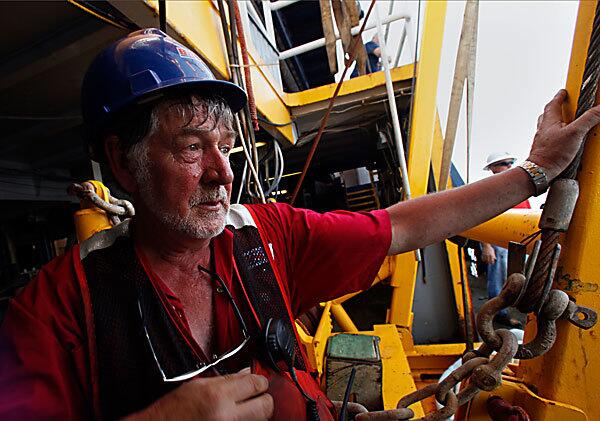
George Ross is part of a team working to burn oil on the surface of the Gulf of Mexico about 7 miles north of the leak. (Carolyn Cole / Los Angeles Times)
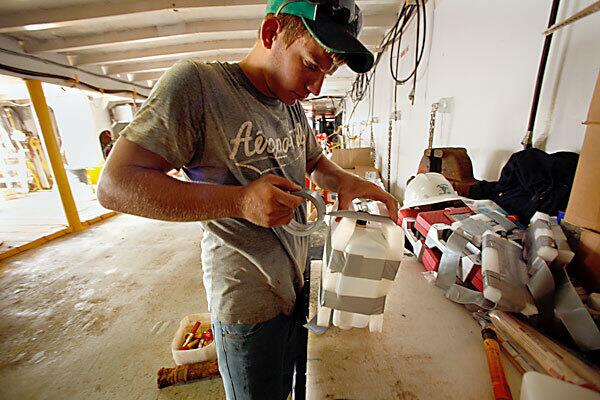
Codie Durham of Kentucky builds ignition devices for burning oil on the surface of the gulf. Two plastic milk jugs are filled with fuel and wrapped with foam. (Carolyn Cole / Los Angeles Times)
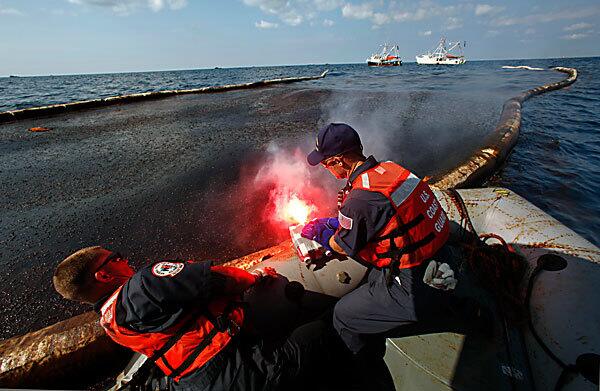
Coast Guard Senior Chief Andrew Jaeger, right, and Petty Officer 3rd Class Tomas Kaselionis ignite oil in the Gulf of Mexico, about seven miles north of the spill site. (Carolyn Cole / Los Angeles Times)
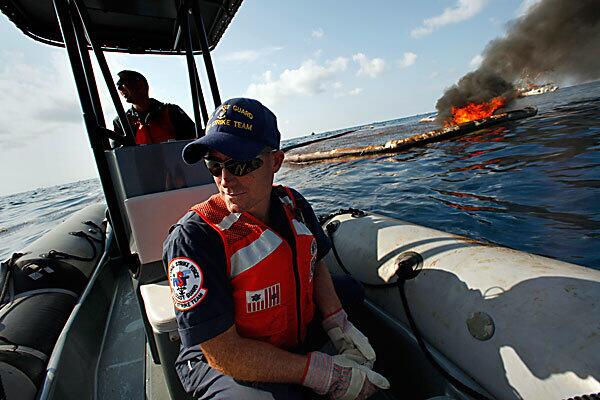
Coast Guard Senior Chief Andrew Jaeger works on a crew burning oil in the Gulf of Mexico. (Carolyn Cole / Los Angeles Times)
Advertisement
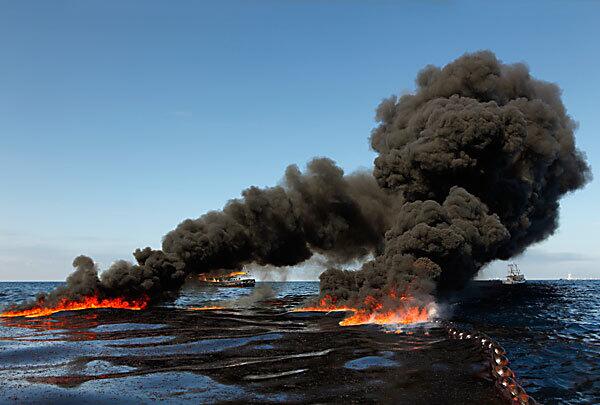
Oil is skimmed by boats and then ignited in the Gulf of Mexico, one of several methods for dealing with the spill. (Carolyn Cole / Los Angeles Times)
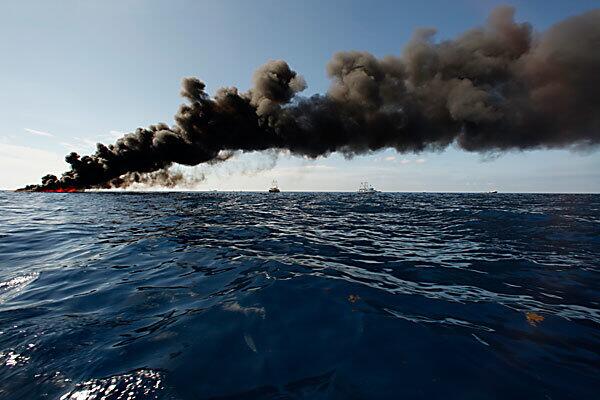
Coast Guard officials and oil industry experts say burning the Gulf of Mexico oil is a critical tool in containing the spill. (Carolyn Cole / Los Angeles Times)
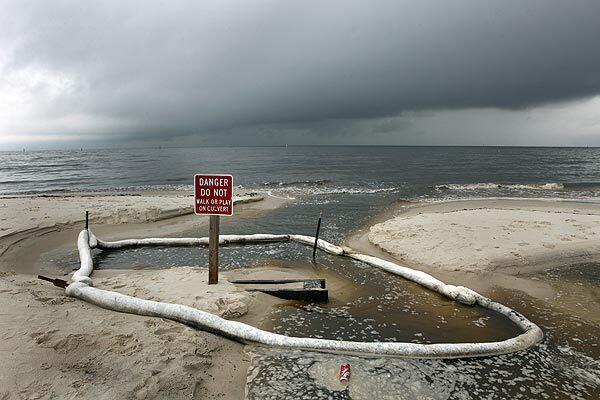
A pool of dirty water is surrounded by a boom on a beach in Gulfport, Miss. “This is heartbreaking ... no people, tar balls on the beach and people cleaning,” one visitor said. (Carolyn Cole / Los Angeles Times)
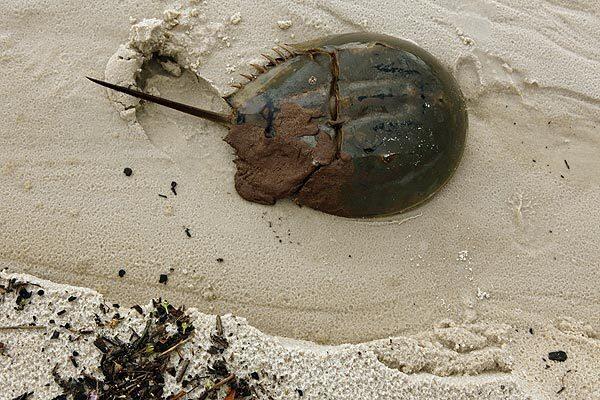
A dead horseshoe crab with tar on its shell washes ashore in Gulfport, Miss. (Carolyn Cole / Los Angeles Times)
Advertisement
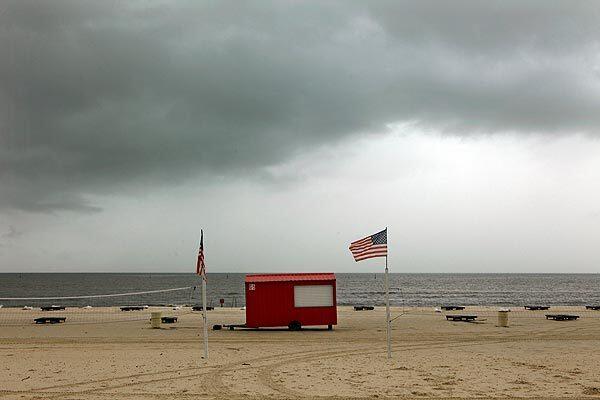
The combination of the oil spill and foul weather triggered by Hurricane Alex left beaches empty in Gulfport, Miss. (Carolyn Cole / Los Angeles Times)
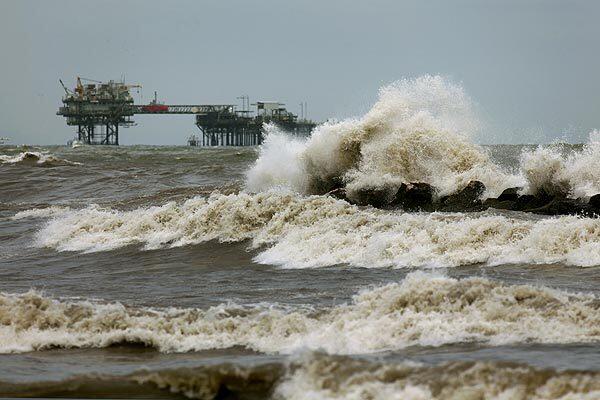
Tropical storm Alex sends 4- to 6-foot swells crashing onto the coastline in Port Fourchon, La. The high surf is hindering oil spill cleanup efforts. (Carolyn Cole / Los Angeles Times)
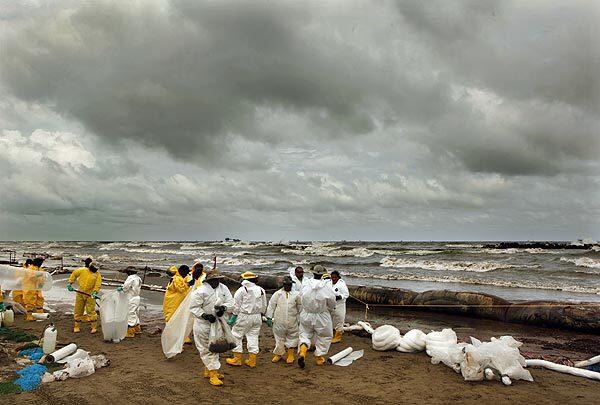
Cleanup crews donning protective uniforms remove oil-soaked sand from a Port Fourchon beach. (Carolyn Cole / Los Angeles Times)
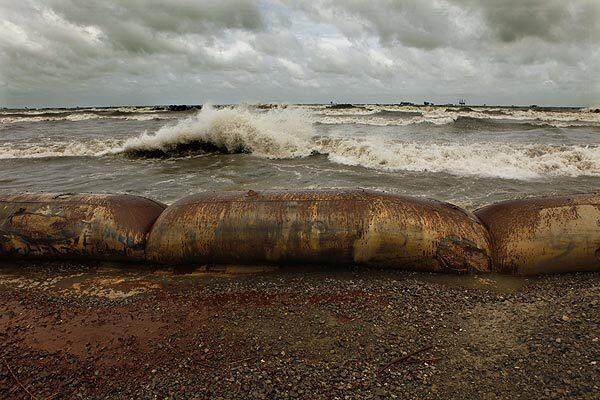
Waves of oil splash over sandbags positioned to keep the crude off the beach. (Carolyn Cole / Los Angeles Times)
Advertisement
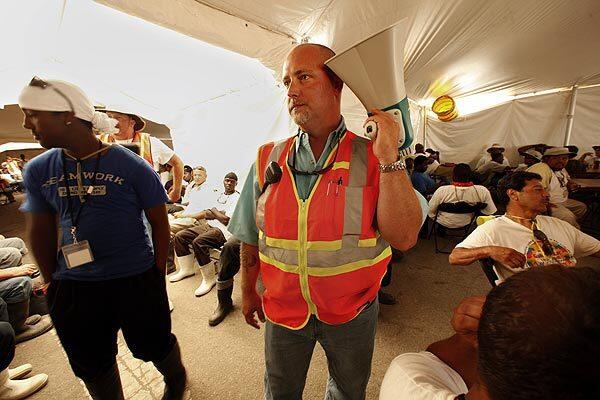
Beach operations manager John Hogan uses a bullhorn to get a message out to the crew in Grand Isle, La., whose work was delayed because of lightning. (Carolyn Cole / Los Angeles Times)
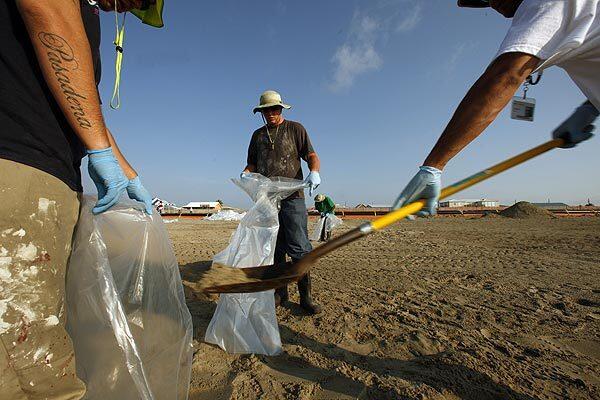
Workers shovel sand into large plastic bags in Grand Isle. More than 1,500 workers have been hired to clean up beaches here and in surrounding areas. (Carolyn Cole / Los Angeles Times)
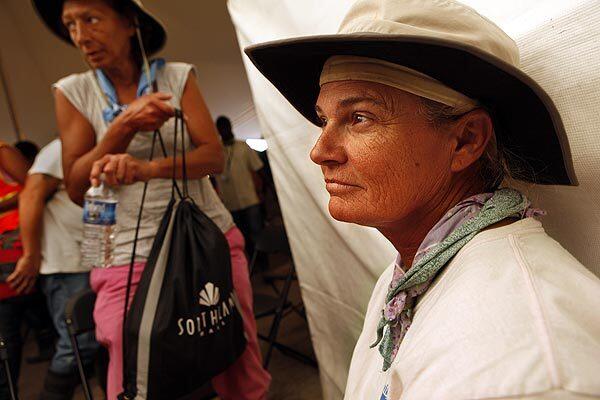
Kathy Flannigan, 53, is part of the cleanup crew in Grand Isle. She and others wait out the storm inside a tent. (Carolyn Cole / Los Angeles Times)
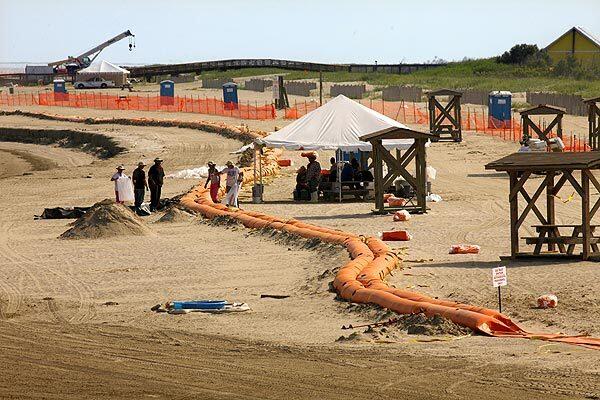
Tiger dams, inflated with water, line the beaches on Grand Isle, where workers pick up their tools at the end of a shift. (Carolyn Cole / Los Angeles Times)
Advertisement
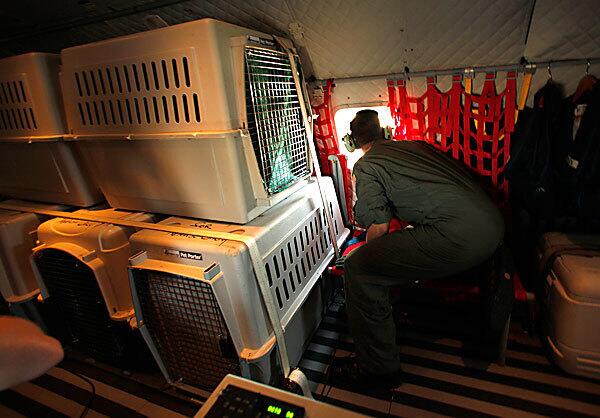
Andrew Anderson of the Coast Guard looks out the window as a plane takes about 70 brown pelicans from Louisiana, where they were rescued from the oil spill and cleaned, to Texas, to be released in the Aransas National Wildlife Refuge. (Carolyn Cole / Los Angeles Times)
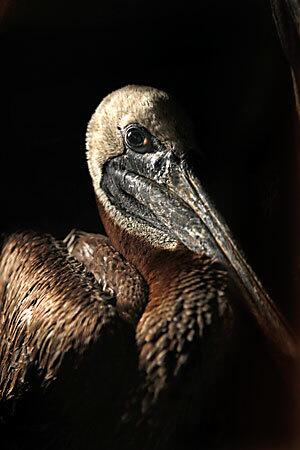
A rehabilitated brown pelican is one of about 70 that was released in a Texas wildlife refuge. (Carolyn Cole / Los Angeles Times)
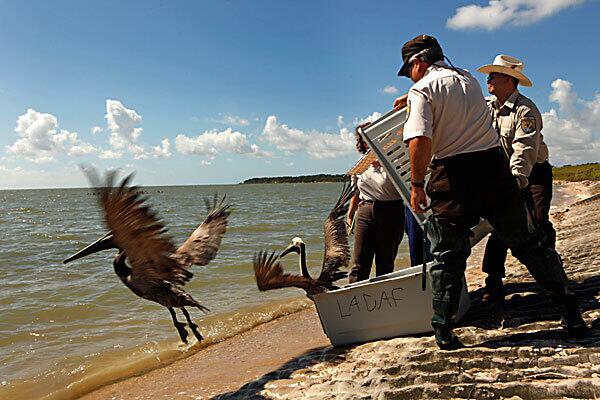
U.S. Fish and Wildlife workers release rehabilitated pelicans back into the wild in Texas. (Carolyn Cole / Los Angeles Times)
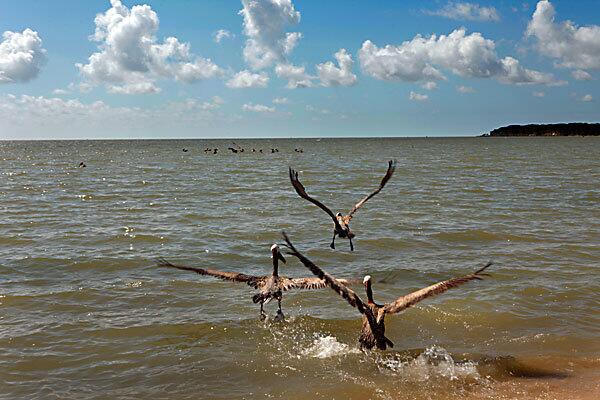
To date, it was the largest release of rehabilitated birds recovered from the gulf oil spill. (Carolyn Cole / Los Angeles Times)
Advertisement
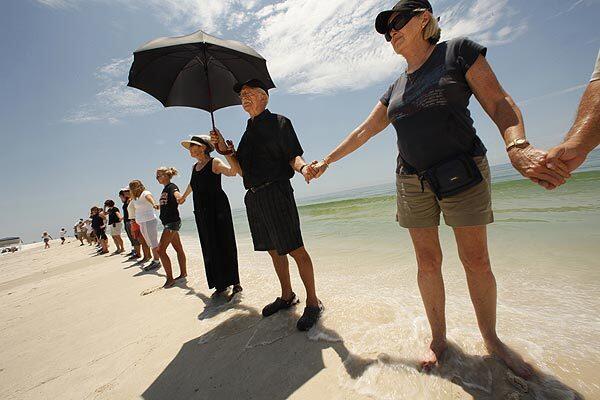
A group gathers on Perdido Key, Fla., as part of the national Hands Across the Sand event to demonstrate concern over the oil spill and deep-water drilling. (Carolyn Cole / Los Angeles Times)
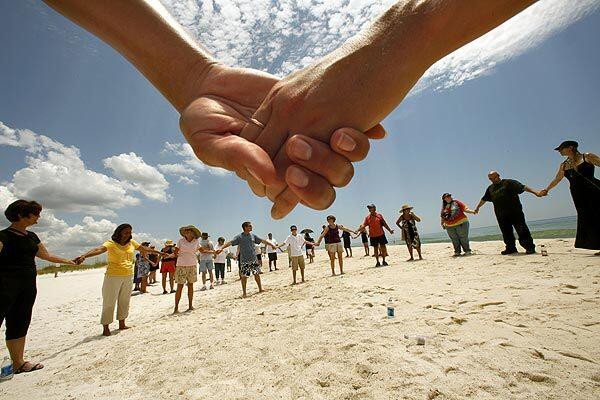
As part of the national Hands Across the Sand gathering, people unite on the beach in an “SOS” formation to show their concern for the gulf oil spill and some to voice their opposition to deep-water drilling. (Carolyn Cole / Los Angeles Times)
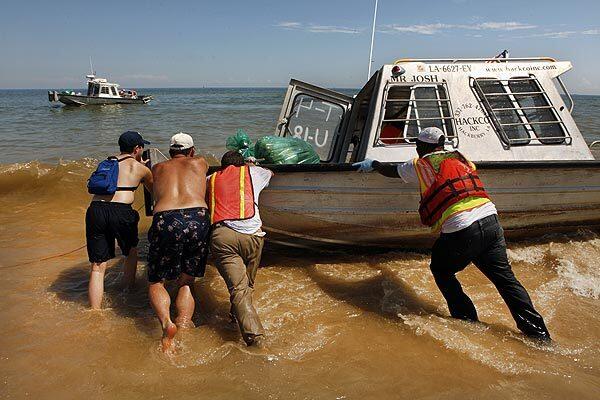
Workers combating the oil spill regain control of their boat that came ashore on Orange Beach, Ala., where oil has stained the waves brown. (Carolyn Cole / Los Angeles Times)
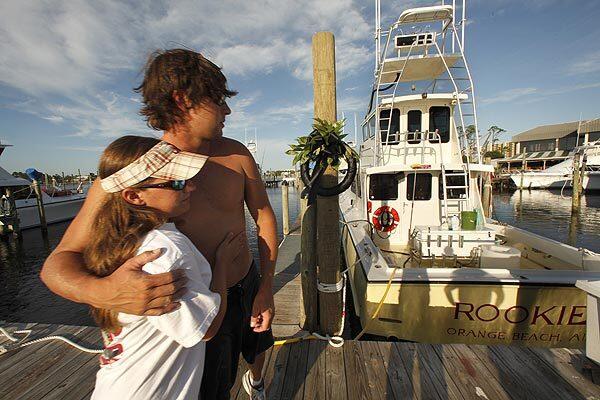
Kelli Kruse is comforted near her father’s boat, the Rookie, which was turned into what BP called a Vessel of Opportunity for the cleanup effort in the Gulf of Mexico. (Carolyn Cole / Los Angeles Times)
Advertisement
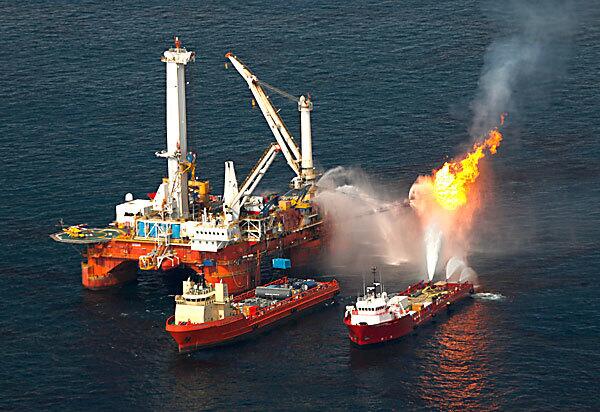
Excess gas from the BP well blowout is burned in the Gulf of Mexico. (Carolyn Cole/Los Angeles Times)
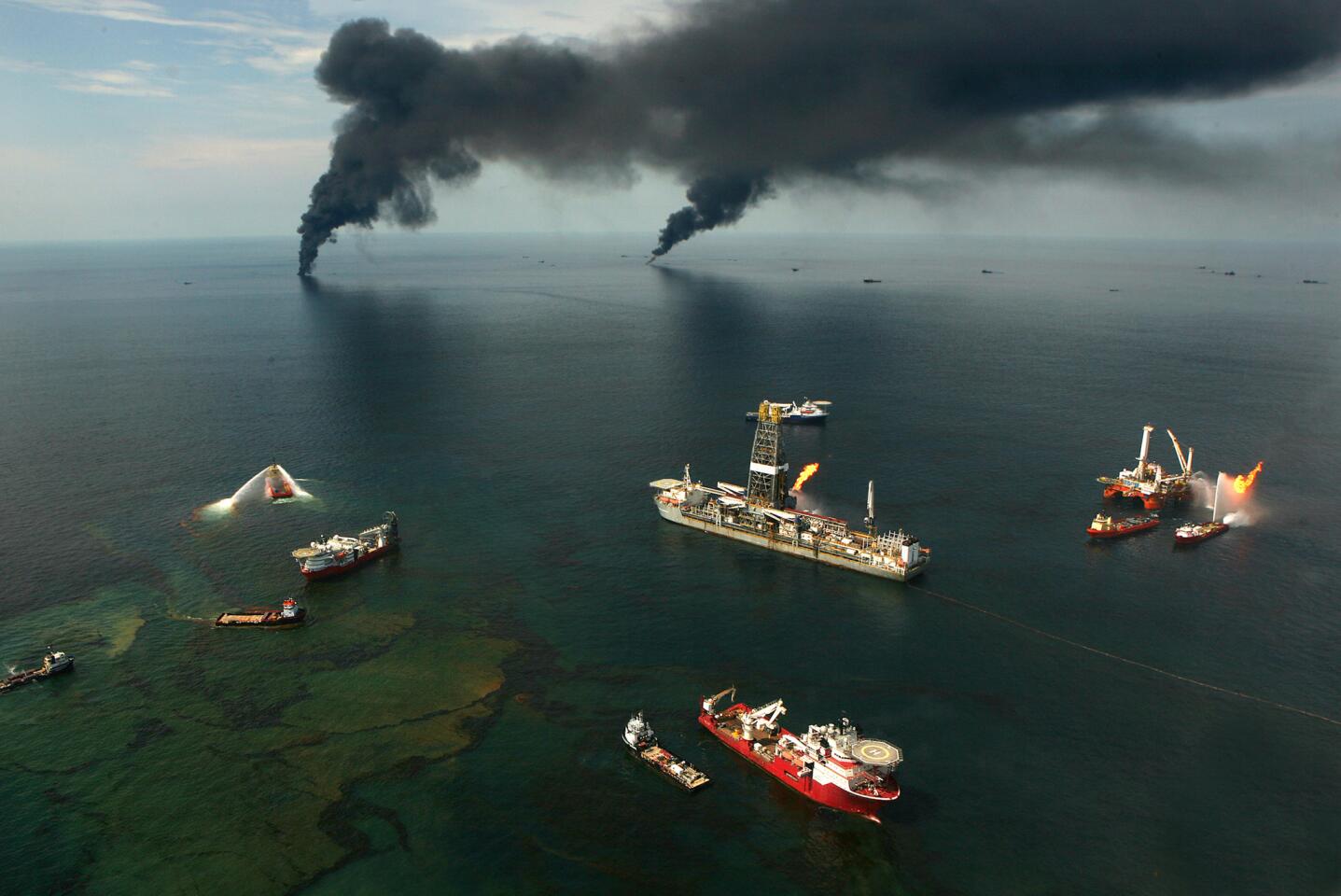
Black smoke rises from pockets of crude being burned in June 2010. Controlled burns removed 11.14 million gallons of oil, The Times found. (Carolyn Cole / Los Angeles Times)
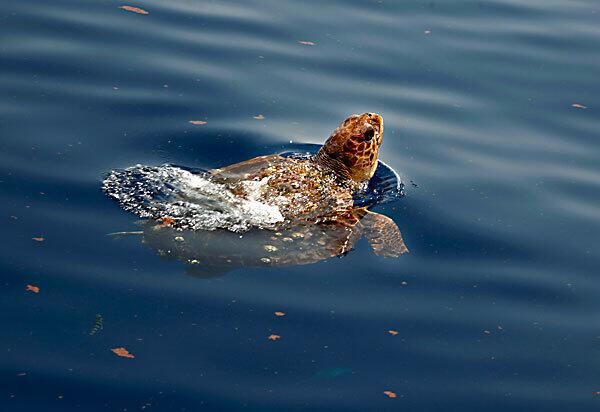
A loggerhead turtle swims in the polluted waters of the gulf. A team of biologists decided not to capture it because it appeared to be in good health. (Carolyn Cole/Los Angeles Times)
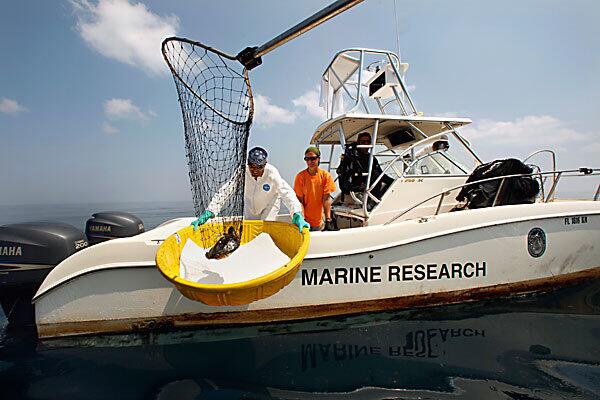
Veterinarian Brian Stacey, left, and Jennifer Muller recover a Kemp’s Ridley turtle affected by the oil spill. Oil may have threatened sea turtles’ breeding tradition. Full story (Carolyn Cole/Los Angeles Times)
Advertisement
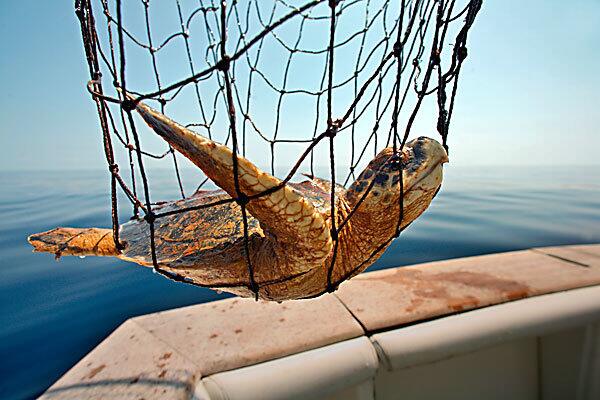
An oil-soaked Kemp’s Ridley turtle is picked up by a team of biologists. The species is endangered. Full story (Carolyn Cole/Los Angeles Times)
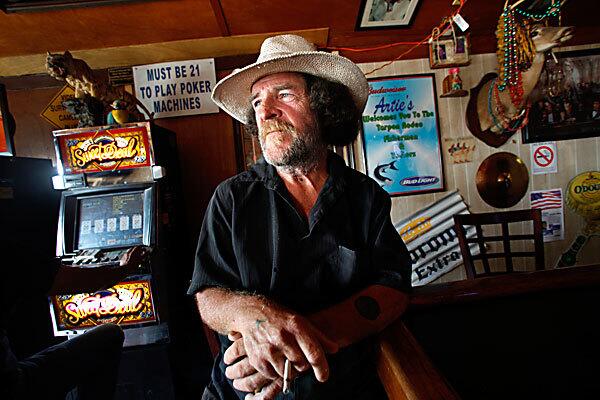
Adam Trahan, 53, has lived in Grand Isle, La., all his life. His job as a deckhand on a shrimp boat has been interrupted by the oil disaster in the gulf. (Carolyn Cole/Los Angeles Times)
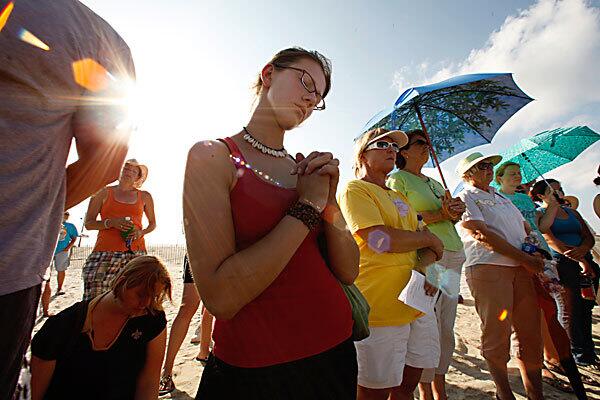
An interfaith prayer service is held at a beach at Grand Isle, La. (Carolyn Cole/Los Angeles Times)
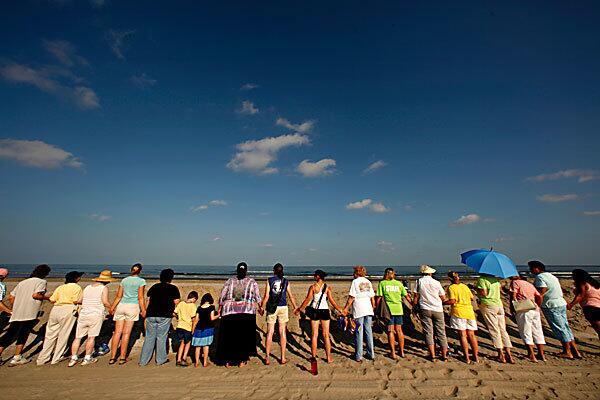
Louisiana residents and visitors gather for an interfaith praying session at Grand Isle. Father Mike Tran is holding weekly services on the beach. (Carolyn Cole/Los Angeles Times)
Advertisement
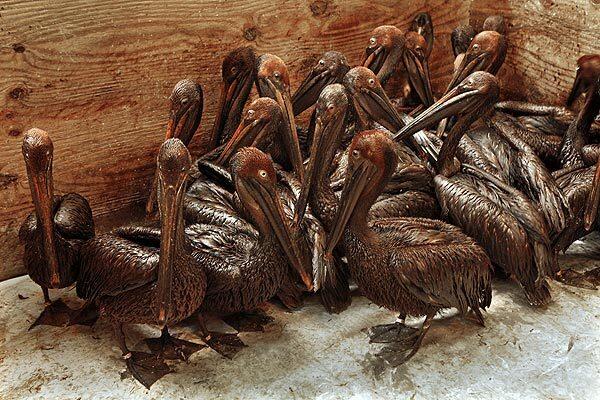
At the Bird Rehabilitation Center in Fort Jackson, La., a group of oiled brown pelicans huddles together as they wait for a bath. More than 40 birds were brought to the center after a wave of oil hit Barataria Bay over the weekend. (Carolyn Cole / Los Angeles Times)
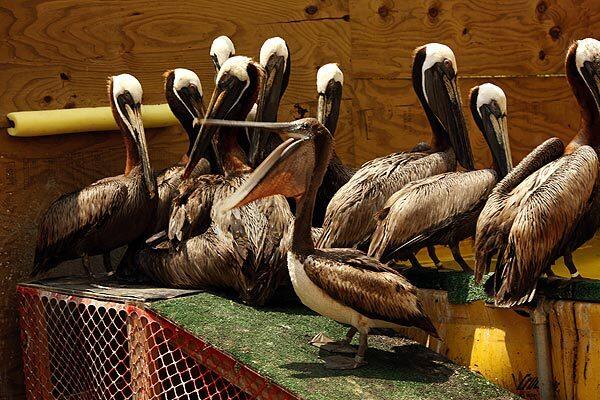
The pelicans’ true colors show after their bath. The birds will recuperate at the center for several days before being released from the eastern side of Florida. (Carolyn Cole / Los Angeles Times)
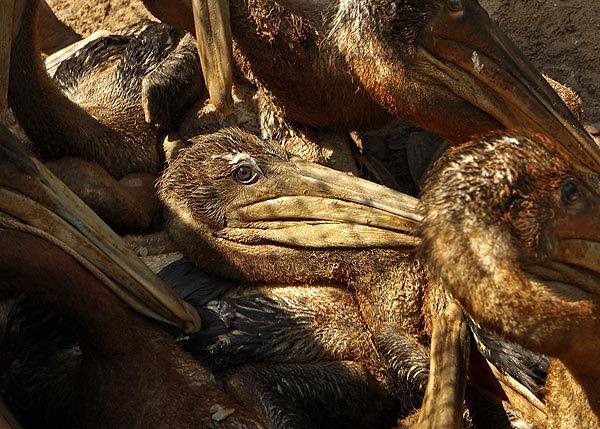
A cluster of 30-week-old brown pelican chicks, some lightly oiled, stick together at the center. (Carolyn Cole / Los Angeles Times)
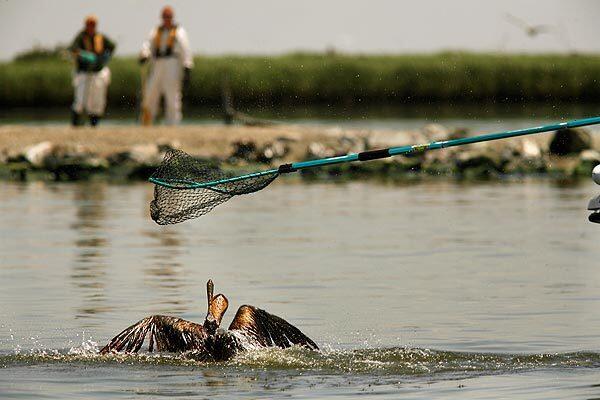
Bird rescuers work to pick up oiled pelicans on Queen Bess Island, La. A second wave of oil started flowing into Barataria Bay, where the island is located, late last week and did heavy damage to rookeries. (Carolyn Cole / Los Angeles Times)
Advertisement
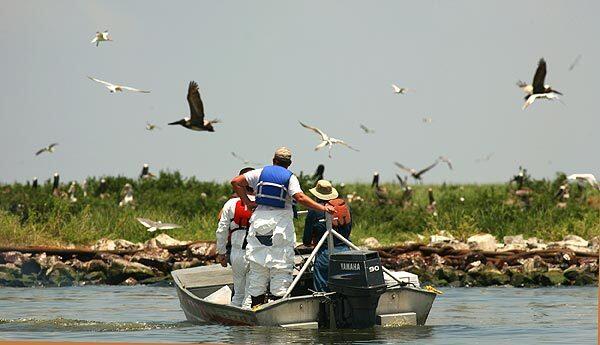
A team of bird rescuers keeps watch at Louisiana’s Queen Bess Island. The island was one of three sites in Louisiana where brown pelicans were reintroduced after they went nearly extinct due to pesticides. (Carolyn Cole / Los Angeles Times)
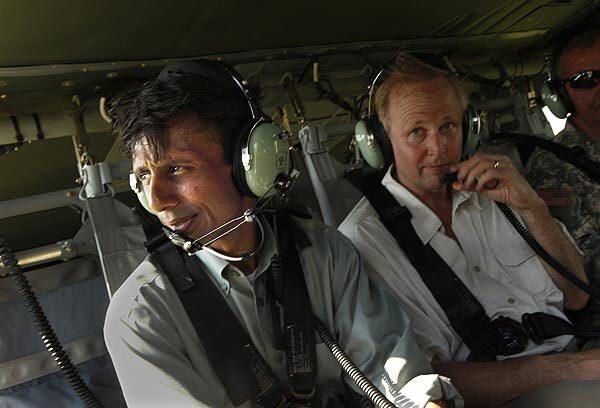
Louisiana Gov. Bobby Jindal, left, and BP Managing Director Bob Dudley tour the oil-affected area of Grand Isle’s Barataria Bay. BP has agreed to pay for six berms to protect the Louisiana coastline. (Carolyn Cole / Los Angeles Times)
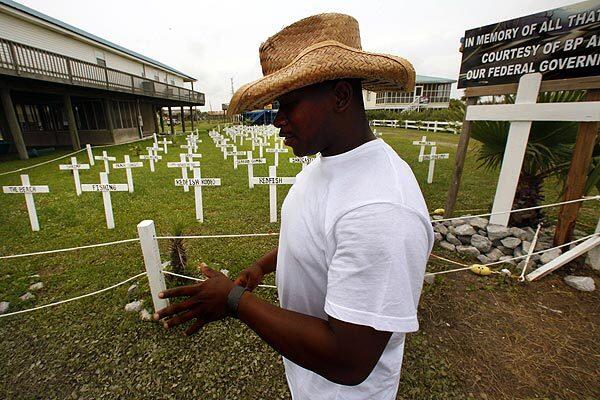
Jonathan Barlow, who had the day off from working on dams to stop the oil smearing Louisiana’s coastline, visits a memorial on Grand Isle marking victims of the oil spill. Barlow, a member of the Louisiana National Guard, has been working to fight the spill since April 29. (Carolyn Cole / Los Angeles Times)
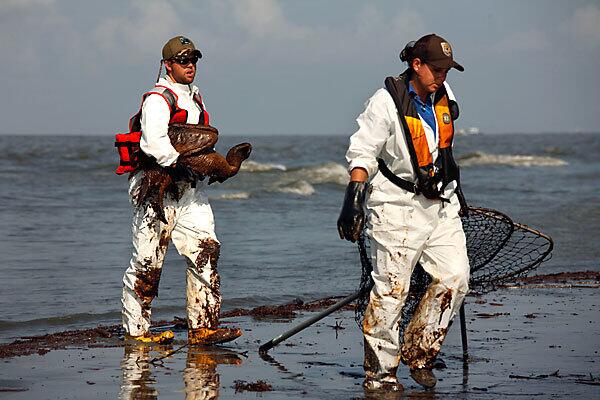
Animal rescue workers pick up a brown pelican at East Grand Terre Island, La. An oiled snake was also found along with one dead bird. (Carolyn Cole / Los Angeles Times / June 6, 2010)
Advertisement
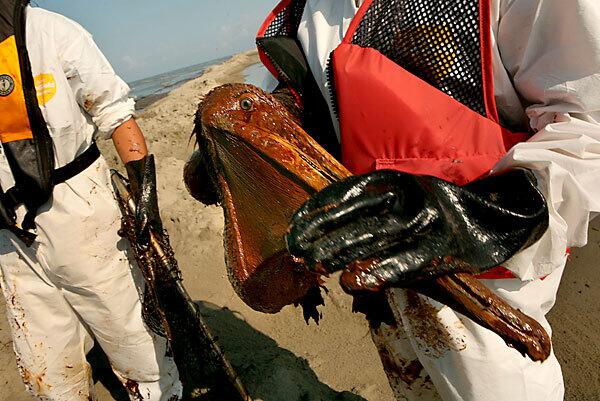
Animal rescue workers pick up an oil-covered brown pelican at East Grand Terre Island, La. (Carolyn Cole / Los Angeles Times / June 6, 2010)
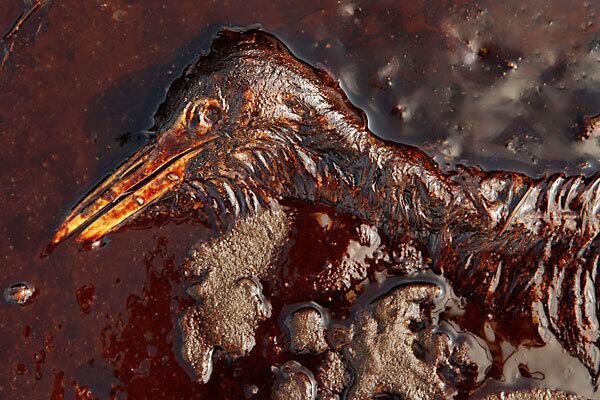
A dead bird lies in a pool of oil on East Grand Terre Island, La. A few minutes later, the tide brought in more oil and covered the bird. Although pelicans are hardy and can be saved if found early enough, smaller birds are more vulnerable to the oil once they are exposed to it. (Carolyn Cole / Los Angeles Times / June 6, 2010)
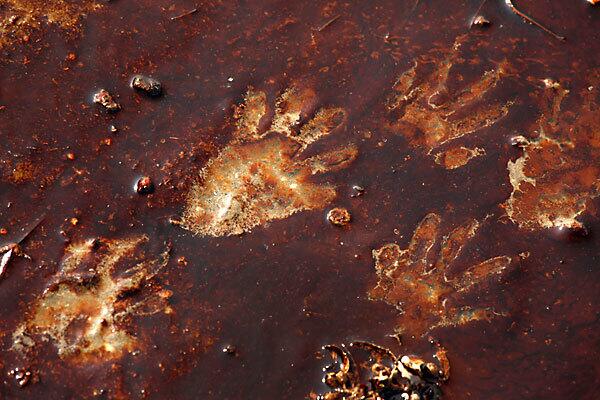
Raccoon prints along the beach on East Grand Terre Island, La., show that birds are not the only animals affected by the oil spill. The animal was not found. (Carolyn Cole / Los Angeles Times / June 6, 2010)
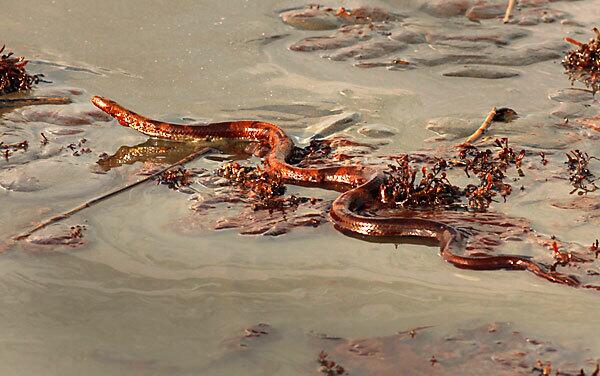
A waterborne snake is stuck in oil on the beach at East Grand Terre Island, La. It was later removed from the oil and cleaned its body off in the sand before it moved into beach grasses. (Carolyn Cole / Los Angeles Times / June 6, 2010)
Advertisement
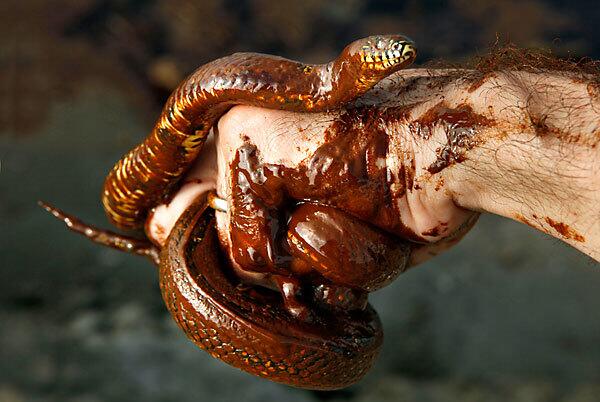
A snake is pulled from an oil-coated beach on East Grand Terre Island, La. The snake’s head was the only part that was not covered in oil. (Carolyn Cole / Los Angeles Times / June 6, 2010)
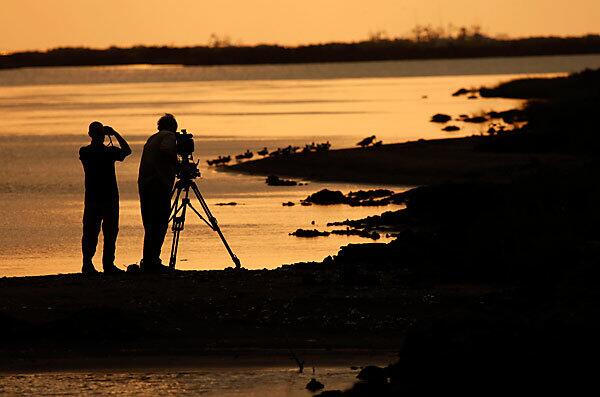
Marc Dantzker, left, a biologist and documentary filmmaker with the Cornell Lab of Ornithology, visits East Grand Terre Island to document the effects of the oil on birds. Dantzker and his crew observed an oiled gull from a distance. (Carolyn Cole / Los Angeles Times / June 6, 2010)
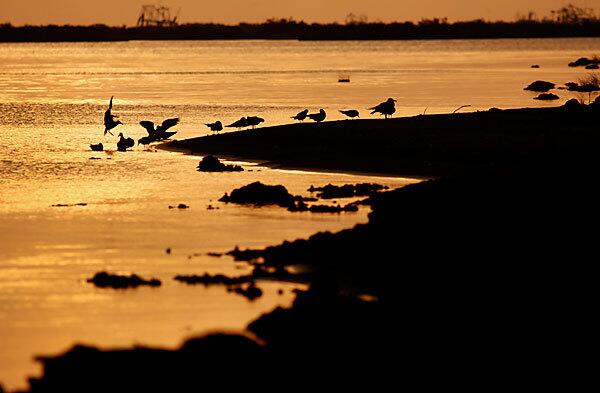
Birds feed on the back side of East Grand Terre Island, La., in a spot where oil does not cover the sand. (Carolyn Cole / Los Angeles Times / June 6, 2010)
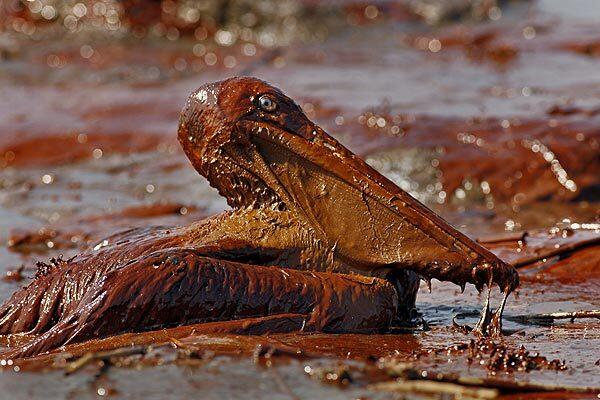
Oil drips from a pelican on Grand Terre Island, La. It was later picked up by rescue workers. (Carolyn Cole / Los Angeles Times)
Advertisement
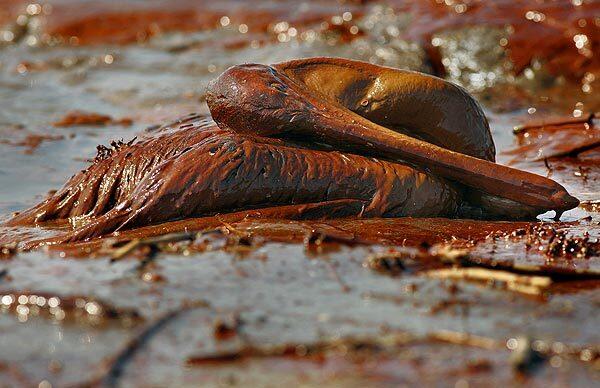
On Grand Terre Island, La., a pelican is still alive but too weak to lift its head. Rescue workers later took the bird to be cleaned. (Carolyn Cole / Los Angeles Times)
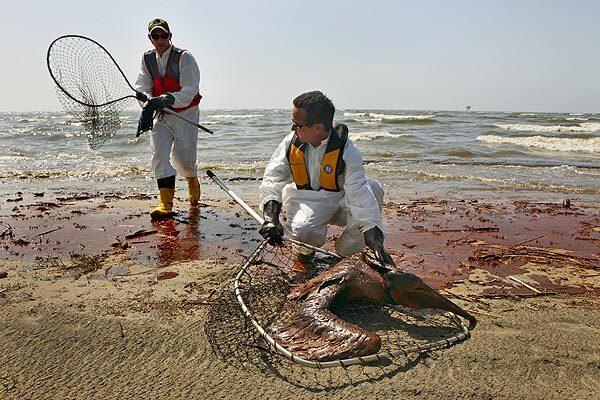
Animal rescue workers hired by BP recover an oil-covered pelican on Grand Terre Island, La. Full story about the wildlife effort (Carolyn Cole / Los Angeles Times)
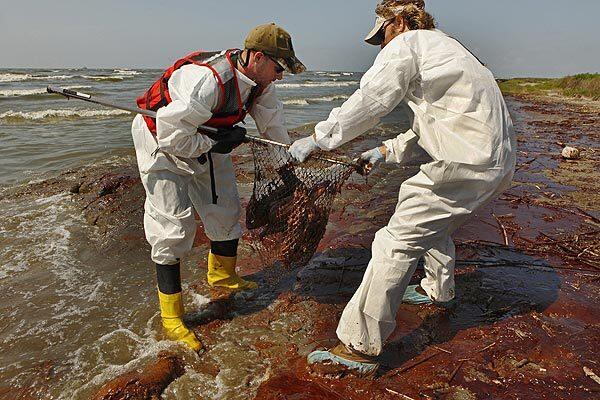
Two rescue workers scoop up a pelican for cleaning. (Carolyn Cole / Los Angeles Times)
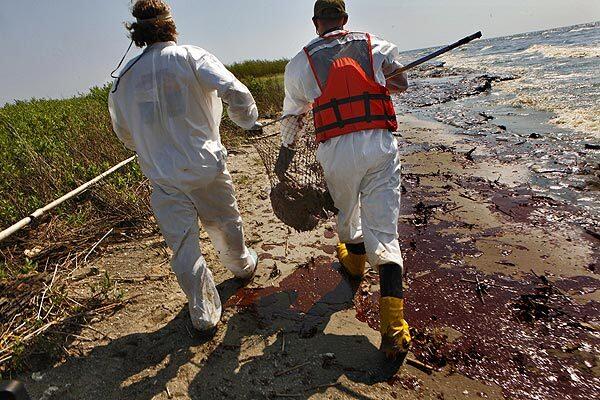
The pelican will be transported by boat to a rehabilitation center in Fort Jackson, La., to be cleaned after it is stabilized. (Carolyn Cole / Los Angeles Times)
Advertisement
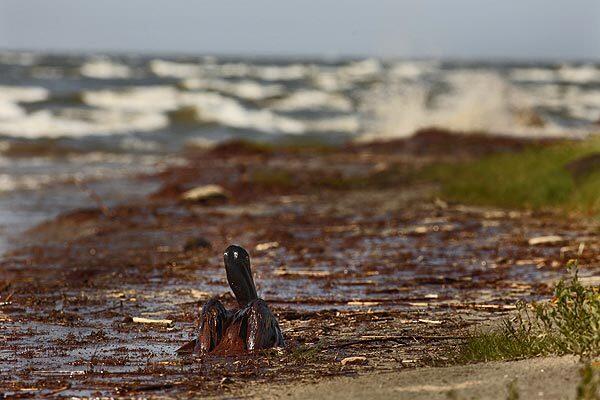
An oil-covered pelican sits in the toxic muck on Grand Terre Island, La. (Carolyn Cole / Los Angeles Times)
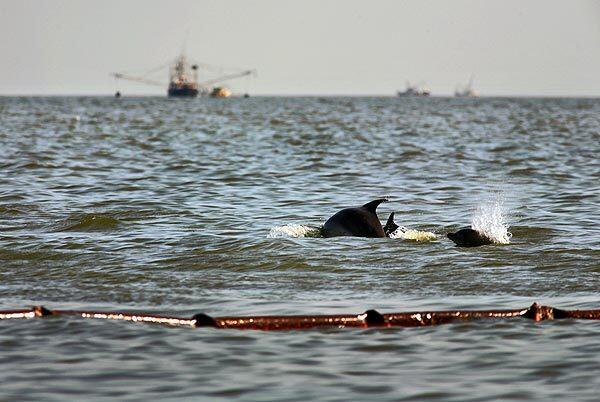
Dolphins swim in contaminated waters off Grand Terre Island, La. Oil could be seen on the dolphins’ fins. (Carolyn Cole / Los Angeles Times)
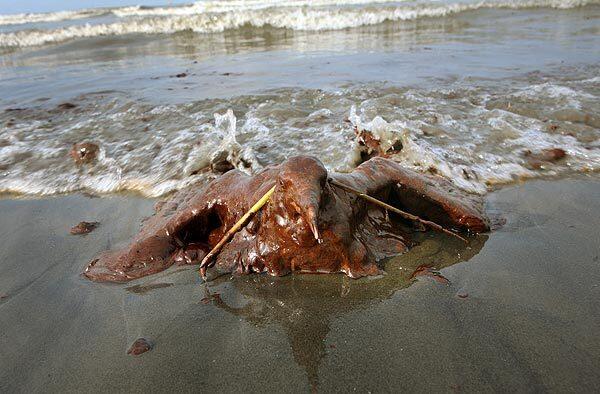
Still alive but practically unrecognizable, a sea gull is paralyzed by oil on the beach at East Grand Terre Island, La., a breading area for wildlife. (Carolyn Cole / Los Angeles Times)
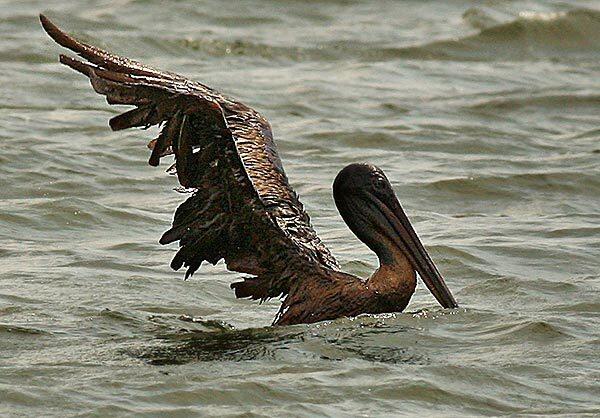
A severely oiled pelican unable to fly floats near East Grand Terre Island, La., where a second wave of heavy oil has arrived. (Carolyn Cole / Los Angeles Times)
Advertisement
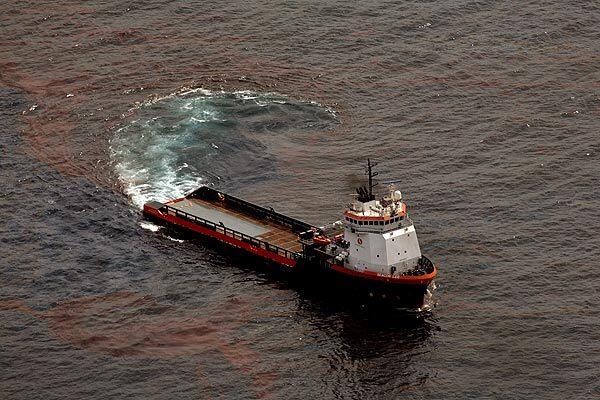
BP has asked for international assistance in skimming oil seeping from their well. (Carolyn Cole / Los Angeles Times)
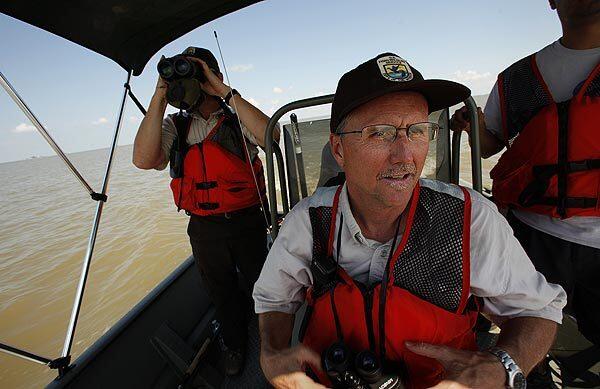
Employees of the U.S. Fish and Wildlife Service search for oiled birds in the gulf. (Carolyn Cole / Los Angeles Times)
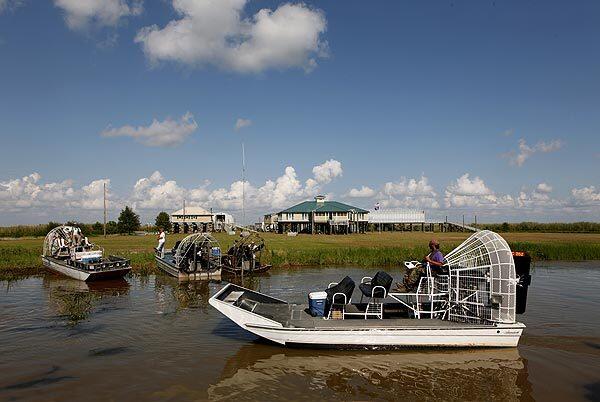
Air boats park at the camp in Dennis Pass, home to members of the Louisiana Wildlife and Fishery that is now being used as a base for the U.S. Fish and Wildlife Service. The air boats are used to search for oiled birds in shallow waters and marsh areas. (Carolyn Cole / Los Angeles Times)
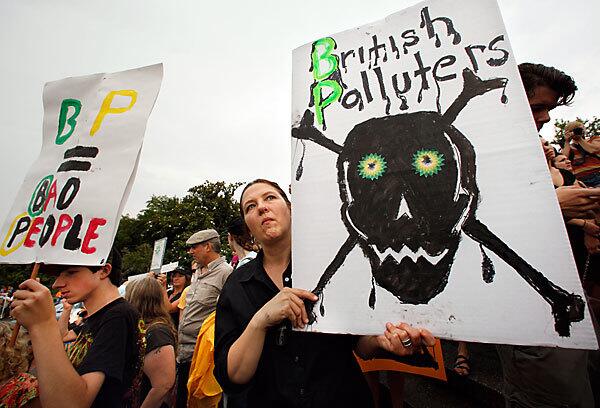
Several hundred demonstrators gathered in New Orlean’s Jackson Square to rally against BP. A blown-out oil well on the bottom of the gulf has been leaking for more than a month. Full protest story (Carolyn Cole / Los Angeles Times)
Advertisement
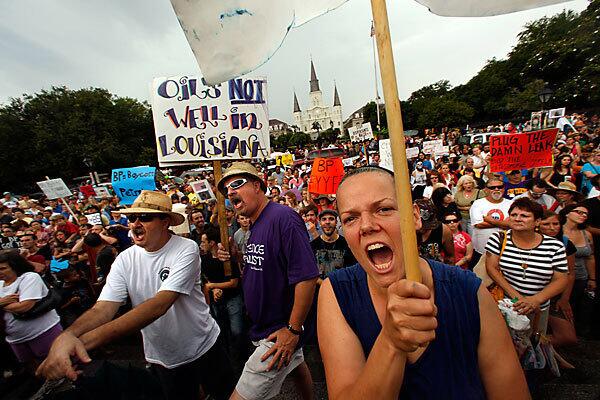
“We are worth more than BP’s bottom line,” reads a sign held by Amy Bohlke, right. (Carolyn Cole / Los Angeles Times)

Mac Mackenzie, center, shows her displeasure at BP during a protest in New Orleans. The “junk shot” refers to one of BP’s failed plans to stop the oil flow from a blown-out well on the gulf floor. (Carolyn Cole / Los Angeles Times)
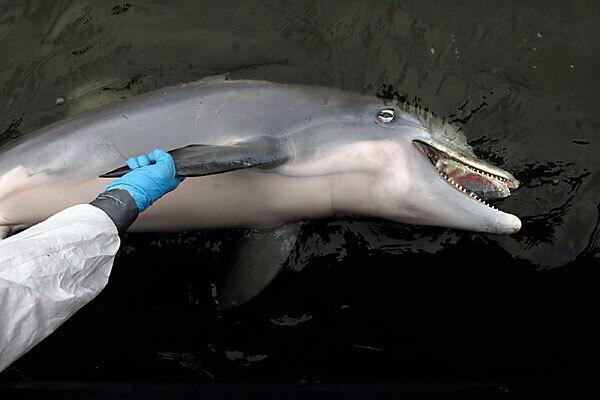
A dead dolphin is recovered off Grand Isle, La. The dolphin will be tested to see if its death was due to exposure to toxins from the oil spill. (Carolyn Cole / Los Angeles Times)
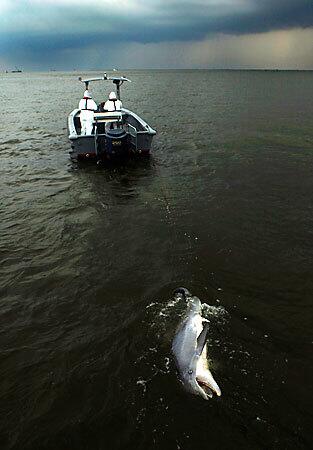
Biologists from the Louisiana Department of Wildlife and Fisheries recover the dead dolphin off Grand Isle, La. The dolphin was towed to shore as a thunderstorm was approaching. (Carolyn Cole / Los Angeles Times)
Advertisement
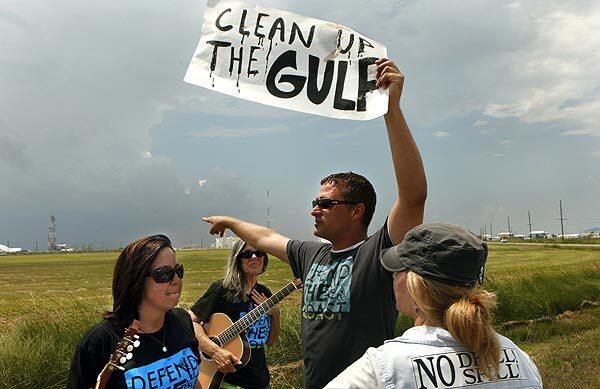
Jonathan Henderson, center, of Gulf Restoration Network and a small group of environmentalists try to get their message to
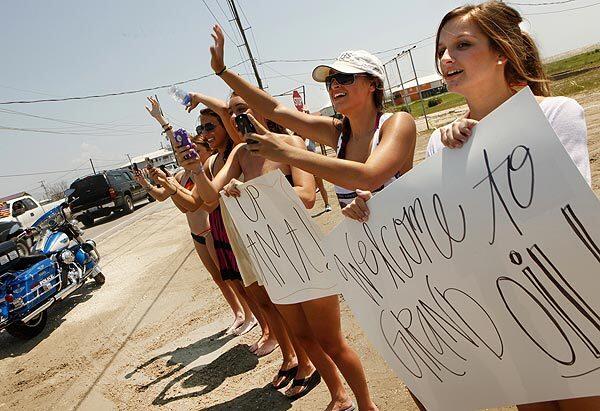
“Welcome to Grand Oil!” says one of the signs held by a group of students in bathing suits from Vandebilt Catholic High School in Houma, La., as
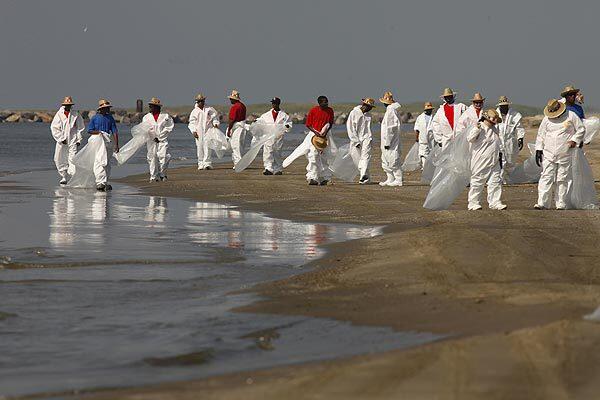
Workers comb the beach of Grand Isle, La., picking up trash in the hours before
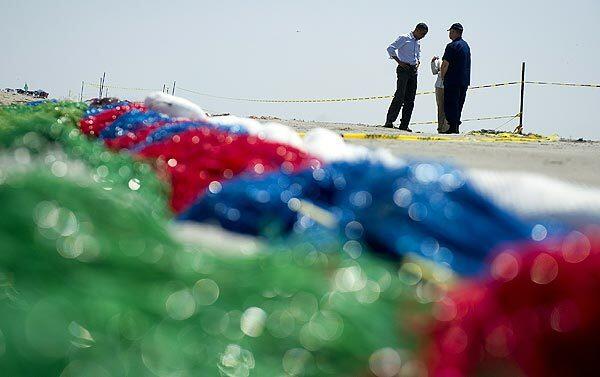
President Obama tours Port Fourchon, La., where the beach was dotted with tar balls and colorful booms. (Jim Watson / AFP/Getty Images)
Advertisement
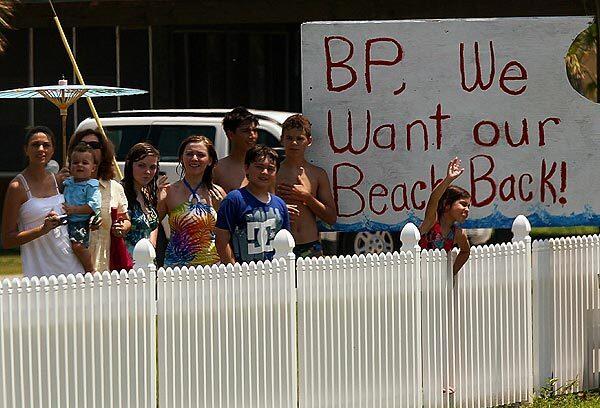
Residents of the Grand Isle, La., area line the road as President Obama’s motorcade passes on the way to Port Fourchon. (Win McNamee / Getty Images)
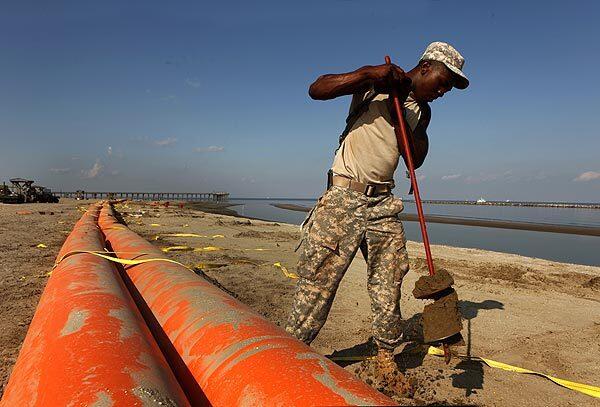
Montrell Baker of the Louisiana National Guard helps efforts to protect the Grand Isle, La., shoreline. (Carolyn Cole / Los Angeles Times)
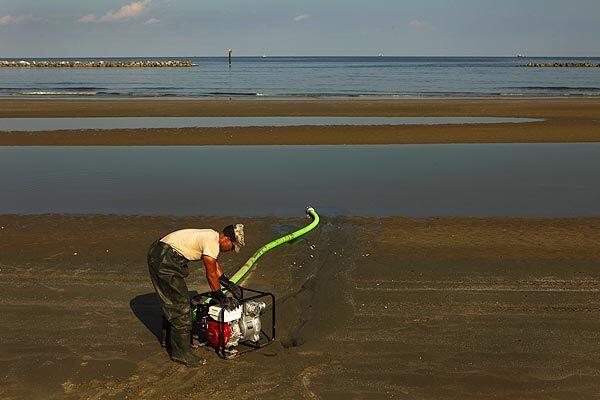
Rashad William of the National Guard pumps water to fill booms. President Obama is expected to visit the region Friday. (Carolyn Cole / Los Angeles Times)
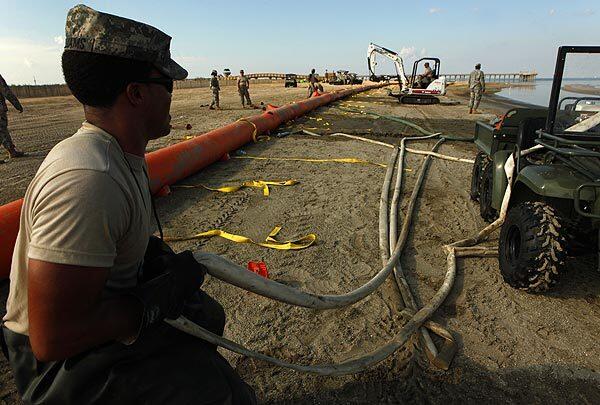
Rashad William, left, works with other Louisiana National Guard troops on containment efforts. (Carolyn Cole / Los Angeles Times)
Advertisement
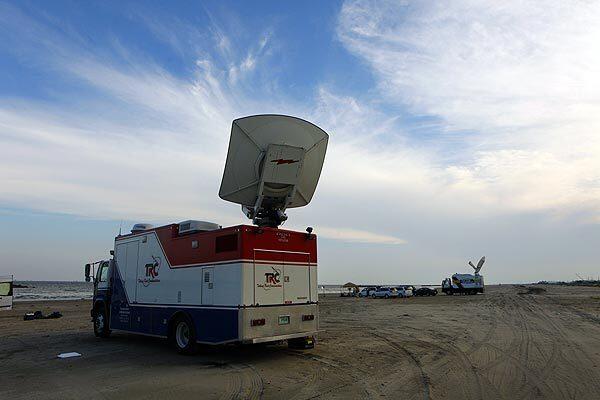
Television crews set up on the beach at Grand Isle, La. (Carolyn Cole / Los Angeles Times)
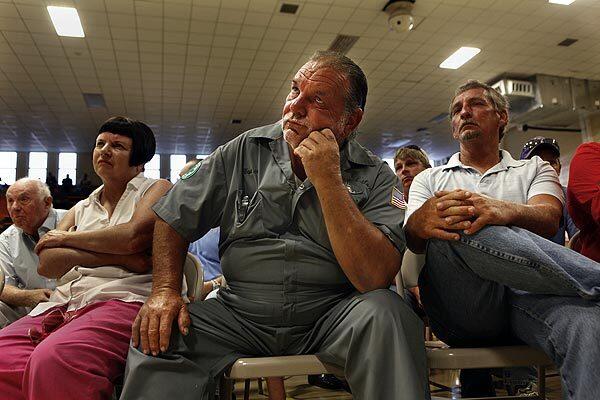
Al Madere, center, and other residents in Plaquemines Parish, La., listen to representatives of BP, the Coast Guard and other agencies at a community meeting Tuesday night. (Carolyn Cole / Los Angeles Times)
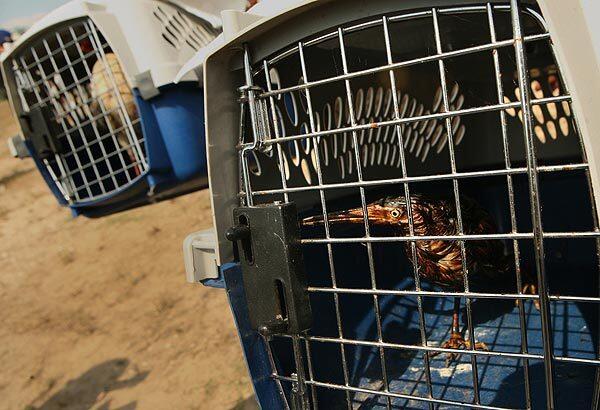
An oiled bird was one of two caught in Pass-A-Loutre, La. (Carolyn Cole / Los Angeles Times)
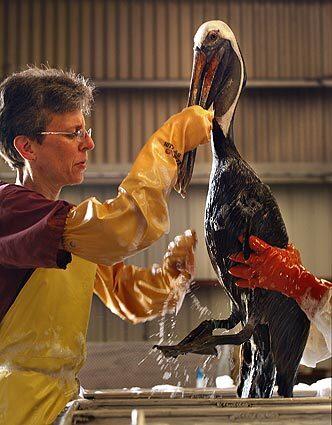
Erica Miller washes an oil-covered pelican at the Fort Jackson Wildlife Rehabilitation Center in Louisiana. The bird was rescued from Barataria Bay. (Carolyn Cole / Los Angeles Times)
Advertisement
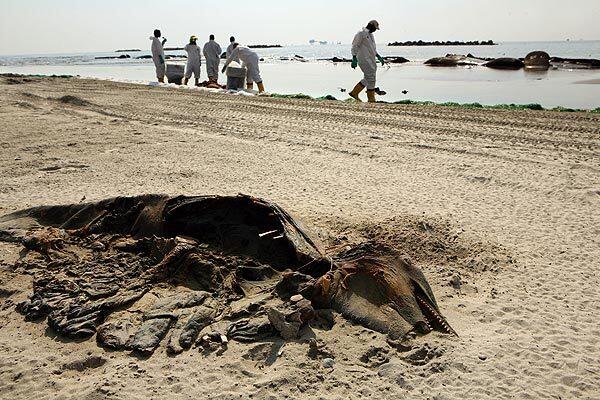
The remains of a dolphin lie beached near Port Fourchon as workers help mop up oil from the Gulf of Mexico spill. (Carolyn Cole / Los Angeles Times)
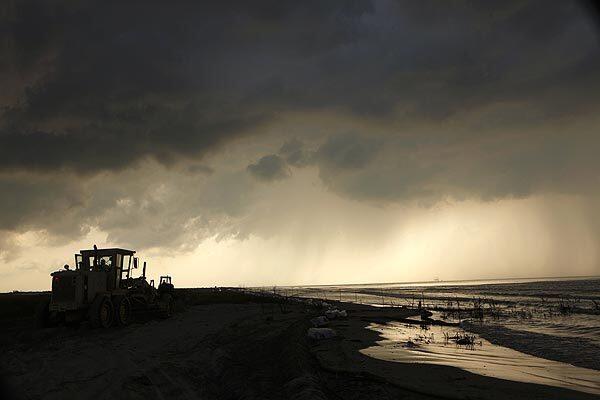
The cleanup work continues on Elmer’s Island, La., where oil began washing up last week. (Carolyn Cole / Los Angeles Times)
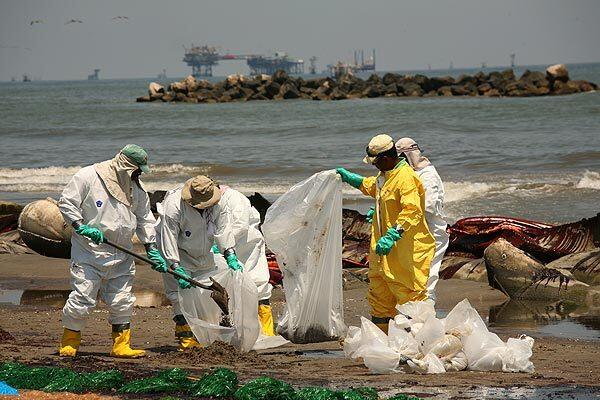
Cleanup work is under way at Port Fourchon, La., where BP Chief Executive Tony Hayward held a news conference Monday. (Carolyn Cole / Los Angeles Times)
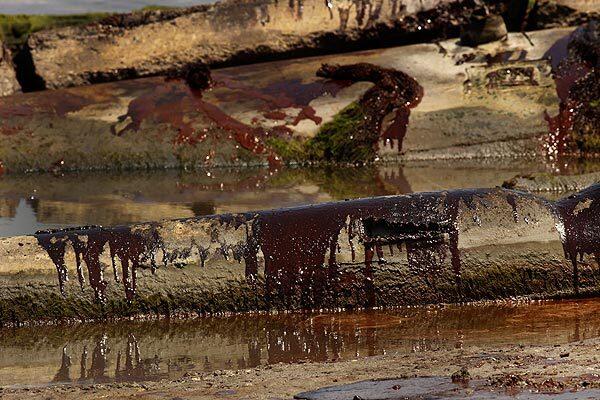
Oil is splashed on the rocks of Port Fourchon, where cleanup operations are under way. (Carolyn Cole / Los Angeles Times)
Advertisement
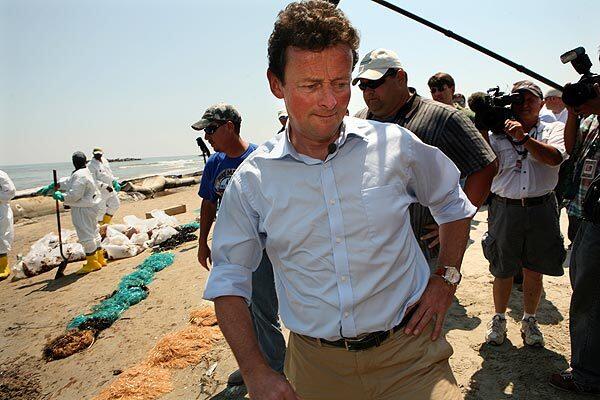
BP Chief Executive Tony Hayward tours his company’s cleanup operations at Port Fourchon. (Carolyn Cole / Los Angeles Times)
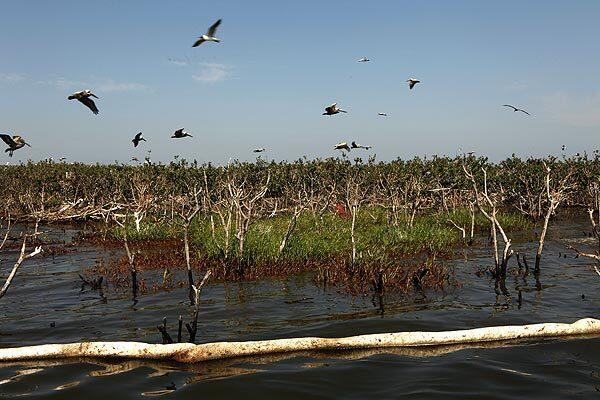
Oil has reached islands close to Grand Isle where thousands of birds are nesting. (Carolyn Cole / Los Angeles Times)
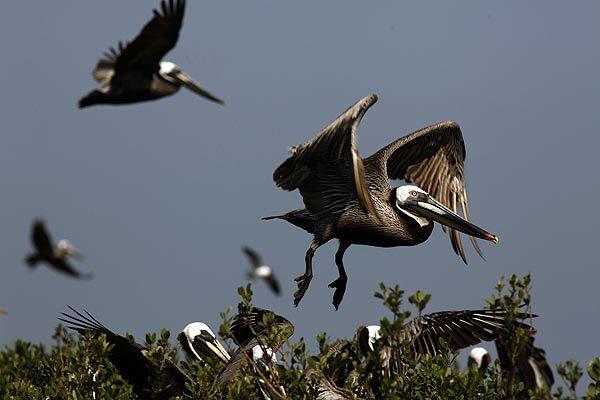
Thousands of brown pelicans and other birds nest on Louisiana islands where oil is making landfall. (Carolyn Cole / Los Angeles Times)
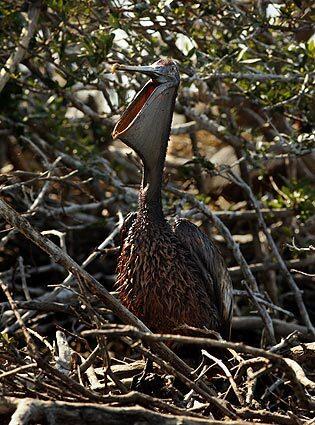
A brown pelican is covered with oil in Barataria Bay, close to Grand Isle. (Carolyn Cole / Los Angeles Times)
Advertisement
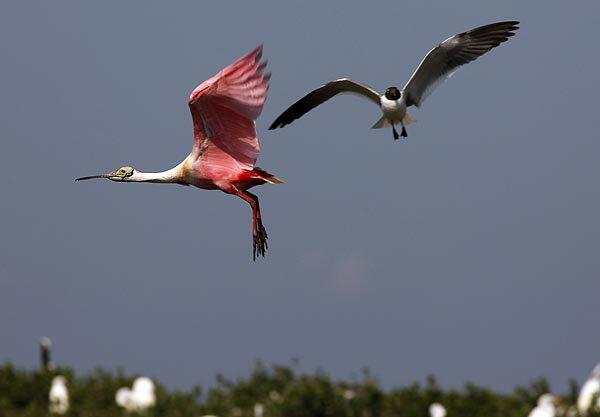
A roseate spoonbill flies near a nesting area in Barataria Bay, where oil has made landfall. (Carolyn Cole / Los Angeles Times)
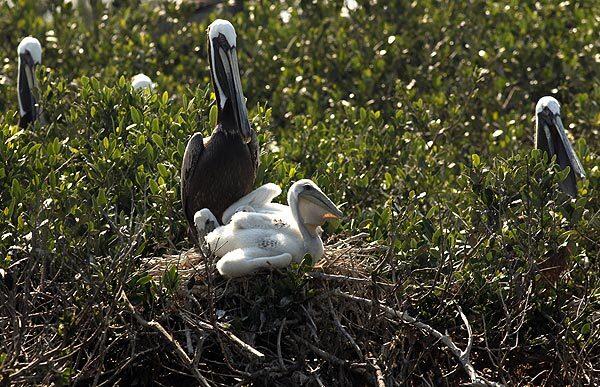
A young pelican sits on its nest as its mother stands by. Oil has reached the shore of islands near Grand Isle where thousands of birds nest. (Carolyn Cole / Los Angeles Times)
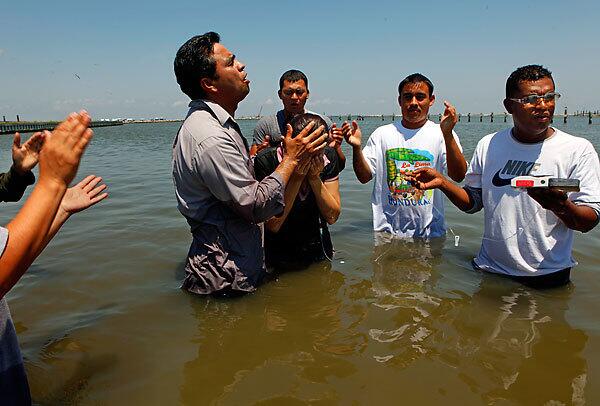
In the bay waters of Grand Isle, La., Pastor Vidal Galvez baptizes two members of his church from Gretna, La., as the oil spill swirls offshore in the Gulf of Mexico. Full story (Carolyn Cole / Los Angeles Times)
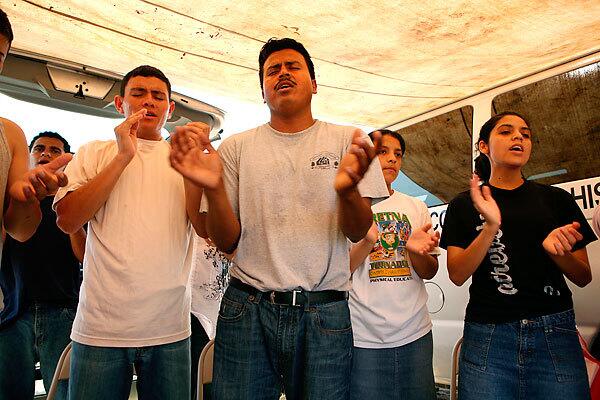
Members of the United Pentecostal Church of Gretna, La., hold a service in the sand. (Carolyn Cole / Los Angeles Times)
Advertisement
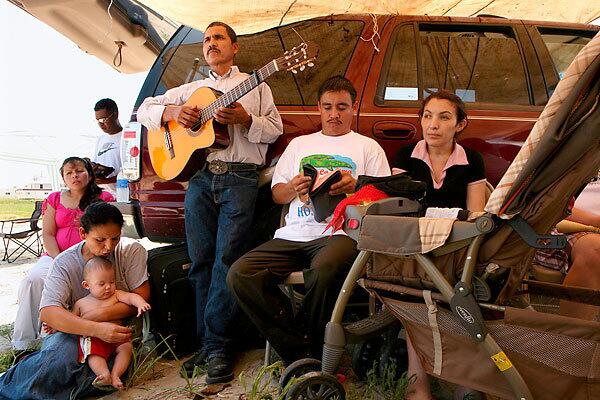
Church members listen as the pastor performs a baptism nearby. (Carolyn Cole / Los Angeles Times)
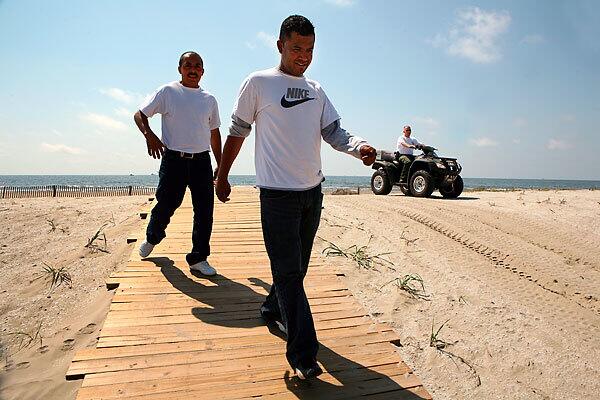
Church members are told to leave a Grand Isle beach, which was closed because of the oil spill. (Carolyn Cole / Los Angeles Times)
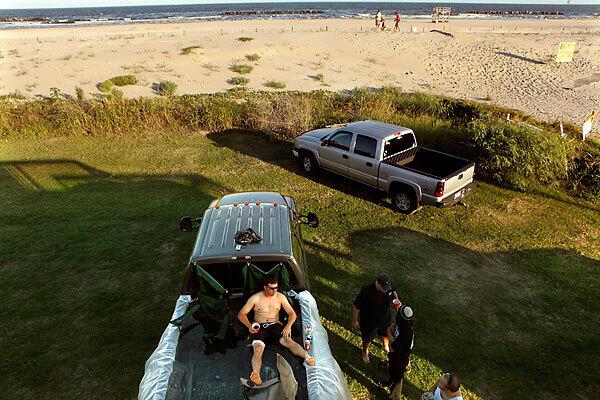
Despite the beach closures in Grand Isle, some residents try to enjoy the good weather. (Carolyn Cole / Los Angeles Times)
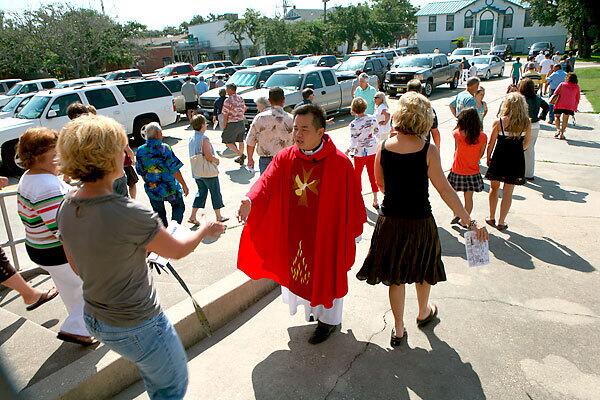
Father Mike Tran greets church members as they leave Our Lady of the Isle Church in Grand Isle. His service focused on making sense of the oil spill, which has washed ashore in the tourist town. Full story of the slick making landfall (Carolyn Cole / Los Angeles Times)
Advertisement
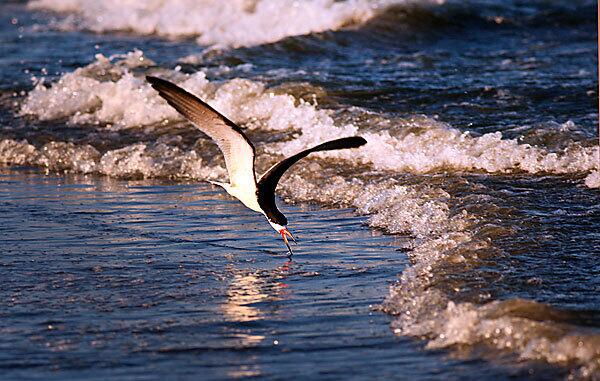
A gull dives in for food along the shoreline at Grand Isle State Beach. Full story of the spill’s effect on wildlife (Carolyn Cole / Los Angeles Times)
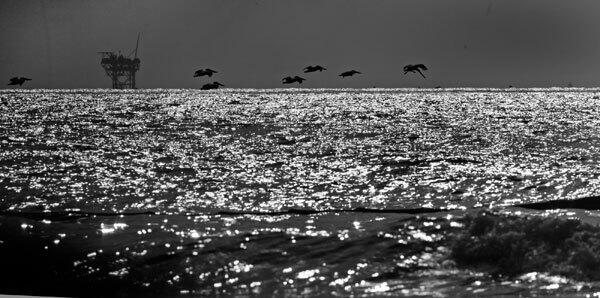
Pelicans fly along the shoreline at Grand Isle State Park as an oil rig looms in the background. (Carolyn Cole / Los Angeles Times)
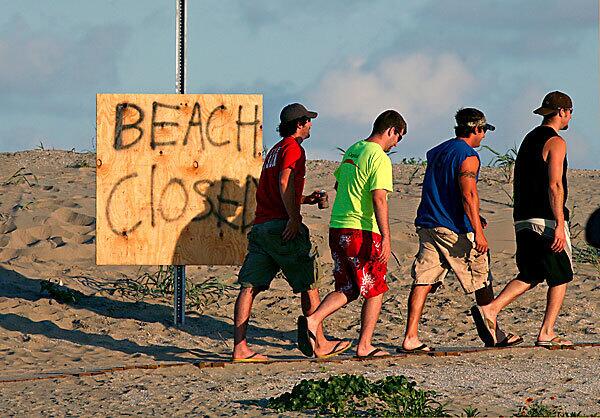
A beach sign tries to warn visitors to Grand Isle, a town of 1,500 that draws thousands of weekend tourists. (Carolyn Cole / Los Angeles Times)
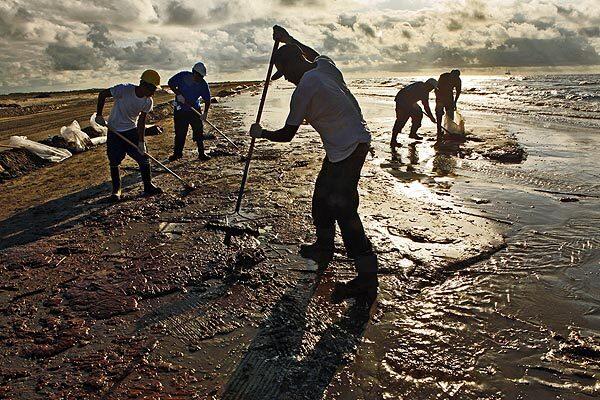
Workers hired by
Advertisement
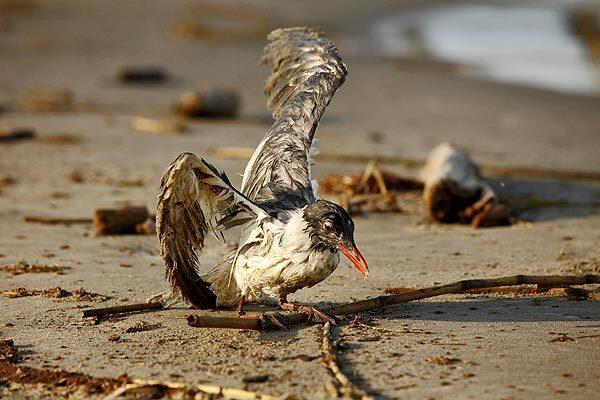
At Grand Isle State Park where the oil spill has come ashore, a sick laughing gull is unable to fly. It died overnight and was removed in the morning by authorities. (Carolyn Cole / Los Angeles Times)
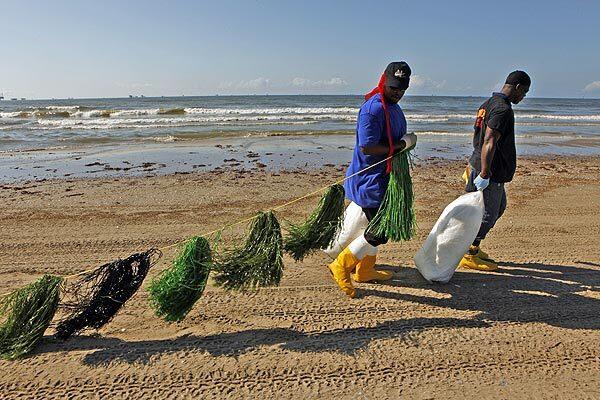
Workers hired by
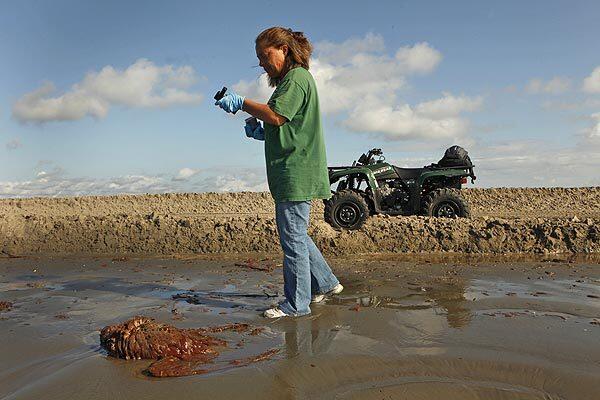
A biologist with the U.S. Fish and Wildlife Service takes the GPS coordinates of an oil-covered dead bird on the beach near Grand Isle, La. (Carolyn Cole / Los Angeles Times)







